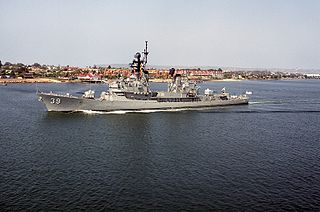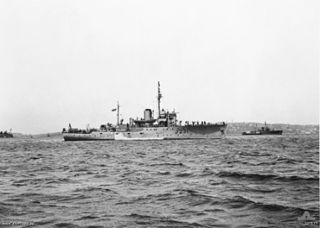
HMAS Murchison (K442/F442) was a Modified River or Bay-class frigate of the Royal Australian Navy (RAN). The ship was laid down in 1943, but not commissioned until after the end of World War II. Murchison fought in the Korean War, was decommissioned in 1956, and sold for scrap in 1961.

HMAS Ararat (K34/M34), named for the city of Ararat, Victoria, was one of 60 Bathurst-class corvettes constructed during World War II, and one of 36 initially manned and commissioned solely by the Royal Australian Navy (RAN).

HMAS Broome (J191), named for the town of Broome, Western Australia, was one of 60 Bathurst-class corvettes constructed during World War II and one of 20 built for the Admiralty but manned by personnel of and commissioned into the Royal Australian Navy (RAN).

HMAS Colac (J242/M05), named for the town of Colac, Victoria, was one of 60 Bathurst-class corvettes constructed during World War II, and one of 36 initially manned and commissioned solely by the Royal Australian Navy (RAN).

HMAS Latrobe (J234/M234), named for the town of Latrobe, Tasmania, was one of 60 Bathurst-class corvettes constructed during World War II, and one of 36 initially manned and commissioned solely by the Royal Australian Navy (RAN).

HMAS Supply was a Tide-class replenishment oiler of the Royal Fleet Auxiliary (RFA) and the Royal Australian Navy (RAN). Originally named Tide Austral and intended to be the first ship of a post-World War II Royal Australian Fleet Auxiliary, manpower and financial shortages meant that when the Belfast-built ship was launched in 1955, she could not be accepted into Australian service. Instead, she was loaned to the RFA, operating RFA Tide Austral (A99). In August 1962, the ship was commissioned directly into the RAN, then renamed a month later to HMAS Supply. Supply operated as part of the RAN until her decommissioning at the end of 1985.

HMAS Tamworth (J181/B250/A124), named for the city of Tamworth, New South Wales, was one of 60 Bathurst-class corvettes constructed during World War II and one of 20 built on Admiralty order but manned by personnel of and later commissioned into the Royal Australian Navy (RAN). Tamworth later saw service in the Royal Netherlands Navy (RNLN) and in the Indonesian Navy (TNI-AL).

The Fremantle-class patrol boats were coastal patrol vessels operated by the Royal Australian Navy (RAN) from 1979 to 2007. Designed by British shipbuilder Brooke Marine and constructed in Australia by North Queensland Engineers and Agents, the Fremantle class were larger, more powerful, and more capable than the preceding Attack class, and the two primary patrol boat bases required infrastructure upgrades to support them. Although up to 30 vessels were planned, fifteen were ordered and constructed, with an unexercised option for five more.

HMAS Hobart was a Perth-class guided missile destroyer of the Royal Australian Navy (RAN). Built in the United States of America to a slight variant of the United States Navy (USN) Charles F. Adams class, she was commissioned into the RAN in 1965. In March 1967, Hobart became the first RAN combat ship deployed to fight in the Vietnam War. This marked the start of consistent six-month deployments to the warzone, which continued until late 1971; Hobart was redeployed in 1969 and 1970. During the 1968 tour, the destroyer was attacked by a United States Air Force aircraft.

HMAS Brisbane was one of three Perth-class guided missile destroyers to serve in the Royal Australian Navy (RAN). The United States-designed ship was laid down at Bay City, Michigan in 1965, launched in 1966 and commissioned into the RAN in 1967. She is named after the city of Brisbane, Queensland.

HMAS Cairns (J183), named for the city of Cairns, Queensland, was one of 60 Bathurst-class corvettes constructed during World War II and one of 20 built for the Admiralty but manned by personnel of and commissioned into the Royal Australian Navy (RAN).

HMAS Bathurst (J158), named for the city of Bathurst, New South Wales, was the lead ship of 60 Bathurst-class corvettes constructed during World War II and one of 20 built for the Admiralty but manned by personnel of and commissioned into the Royal Australian Navy (RAN). Constructed during 1940, the ship spent most of her early career operating with the British Eastern Fleet in the Indian Ocean. She returned to Australian waters in late 1944, then was deployed to New Guinea in 1945, but saw little action. Bathurst was paid off in 1946, and sold to a Sydney scrap merchant in 1948.

HMAS Wallaroo (J222), named after the town of Wallaroo, South Australia, was one of 60 Bathurst-class corvettes constructed during World War II, and one of 36 initially manned and commissioned solely by the Royal Australian Navy (RAN). Wallaroo was one of only three Bathursts lost during World War II; following a collision with US Liberty ship Henry Gilbert Costin on the night of 11 June 1943.

HMAS Dubbo (J251/M251), named for the city of Dubbo, was one of 60 Bathurst-class corvettes constructed during World War II, and one of 36 initially manned and commissioned solely by the Royal Australian Navy (RAN).
The Australian Hydrographic Service is the Australian Commonwealth Government agency responsible for providing hydrographic services that meet Australia's obligations under the SOLAS convention and the national interest; enabling safe navigation, maritime trade and supporting protection of the marine environment. The agency, headquartered at the Australian Hydrographic Office in Wollongong, New South Wales, is an element of the Royal Australian Navy (RAN), and serves both military and civilian functions. The names Australian Hydrographic Service and the Australian Hydrographic Office are commonly abbreviated as AHS or AHO respectively.

HMAS Bundaberg (J231/M231), named for the city of Bundaberg, Queensland, was one of 60 Bathurst-class corvettes constructed during World War II, and one of 36 initially manned and commissioned solely by the Royal Australian Navy (RAN).

HMAS Gawler (J188/B241/A115), named for the town of Gawler, was one of 60 Bathurst-class corvettes constructed during World War II and one of 20 built for the Admiralty but manned by personnel of and commissioned into the Royal Australian Navy (RAN). The ship was laid down by BHP at its Whyalla shipyard in early 1941, launched later that year, and commissioned in 1942.

HMAS Geelong (J201), named for the city of Geelong, Victoria, was one of 60 Bathurst-class corvettes constructed during World War II, and one of 36 initially manned and commissioned solely by the Royal Australian Navy (RAN).
Lombrum Naval Base, also known as HMPNGS Tarangau and formerly PNG Defence Force Base Lombrum, is a naval military base operated by the Maritime Operations Element of the Papua New Guinea Defence Force (PNGDF). It is located on Manus Island in Papua New Guinea. Lombrum is the home port of the PNGDF's Pacific-class patrol boat force.

HMAS Warreen was a survey vessel and general purpose vessel of the Royal Australian Navy (RAN). She served twice with the RAN, as HMAS Stella during World War II and as HMAS Warreen from 1952 until 1969.

















